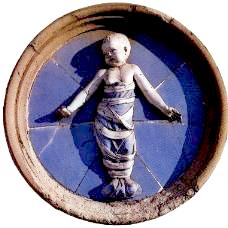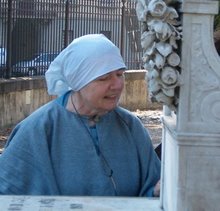
It has been an intense week. Already on the preceding Wednesday, 12 May, had been a UNESCO conference on Traditional Knowledge. At which the mayors of the local comunes were speaking of the need to repair Tuscany's dry walls, her terraces, many destroyed in the heavy rains of the 1966 Flood, and of needing money for this. But no one knows any longer how to build dry walls or wants to work that hard. And I suggested the Roma, who have rebuilt our dry walls expertly, the whole family working together, the women holding babies in their arms telling the men where to place the stones, the brothers and husbands throwing the stones to each other and catching them, and putting them in place, and the very long wall they built in two hours having held the hill now for nine years.
Then Thursday through Saturday the European Union's Commission's European Social Fund meeting at the Ospedale degli Innocenti on Social Exclusion and Education. Again I got to speak of the Roma from Romania and the 'English' Cemetery and how excellent their work is. And how important it is to give them literacy. To my amazement one Commission member, Irini Pari, placed me on her blog.http://www.eesc.europa.eu/organisation/vicepresidents/pari/blog/template_archives_cat.asp?cat=19
And on Friday at 3:30 p.m. was the UNESCO Memory of the World Exhibition at Santa Croce. So I was madly cycling between the two and there I met Joie Springer, who will be coming here today to see the 'English' Cemetery. And one of the Memory of the World treasures was the 1840 Waitangi Treaty with the New Zealand Maori chiefs and the white settlers. Now Peter Neville and his wife came to this 'English' Cemetery in a pouring rainstorm and Peter, who is Maori, recited his genealogy back to the signer of the 1840 Waitangi Treaty and to the Maori settler from Polynesia!
http://www.umilta.net/Maori1.mp3
Then, Saturday afternoon, was the awarding of prizes by the Arciconfraternita della Misericordia in photography and poetry. I didn't expect my photographs to win because they are too controversial though absolutely the theme of diversity. One was called Osmannoro Poverty, the other Osmannoro Bellezza. Since the time they were taken and submitted the police had bulldozed Margarita's shack at Osmannoro built from materials no one else wanted and she and her family, including Printsu below, were having to sleep in the streets in groups of no more than three. And it was the bitterest winter we have experienced in years.
Margarita is to the left and she is our excellent gardener. She also sewed her skirt herself. When she smiles she is beautiful.

Povertà

Bellezza
Now the Misericordia has a most beautiful but abandoned cemetery next door to ours. I am suggesting to them our workers. They could restore the splendid nineteenth funerary carriages in black and white. Our cemeteries with that of San Miniato a Monte could become together Florence's Père Lachaise.
We seek funds to pay these people to garden, and do other work restoring the 'English' Cemetery so they can repair their roofs, school their children, learn the alphabet. They already have wonderful skills as blacksmiths, stonemasons, carpenters, gardeners.
The Roma babies are wrapped up in fasces like those on the Ospedale degli Innocenti and almost never cry, from feeling so secure, so loved. This is Printsu whose parents are working here to find the money for his hospital care in Romania. He is anemic from lack of milk. The stress caused his mother not to have enough. His parents, who are all of eighteen, are sleeping under the loggia of the Innocenti at night. I have been teaching them to write their names and the alphabet so they can become members of our association and work in the Cemetery. They go home on Tuesday to be with their baby.



